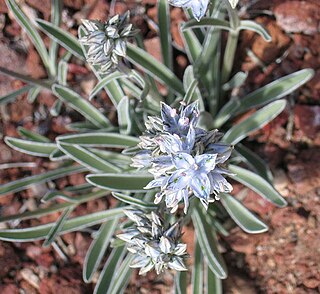
Frasera albicaulis is a species of flowering plant in the gentian family known by the common name whitestem frasera. It is native to the northwestern United States, where it grows in open areas in mountain habitat. It is a perennial herb growing from a woody base surrounded by rosettes of leaves, its stem growing 10 to 70 centimeters tall. The leaves are green with white margins. The basal leaves are lance-shaped, up to 30 centimeters long, and borne on petioles. Leaves higher on the stem are smaller and narrower and are oppositely arranged. The inflorescence is a dense panicle atop the stem, sometimes interrupted into a series of clusters of flowers. Each flower has a calyx of four pointed sepals and a corolla of four pointed lobes each one half to one centimeter long. The corolla is pale greenish white to light blue to purple, often dotted, streaked, or veined with darker blue. There are four stamens tipped with large anthers and a central ovary.

Frasera albomarginata is a species of flowering plant in the gentian family known by the common name desert green gentian, or desert frasera.
Frasera fastigiata is a species of flowering plant in the gentian family known by the common name clustered green gentian. It is native to the northwestern United States, where it grows in meadows and other mountain habitat. It is a perennial herb producing a single stem which grows erect and often exceeds a meter in height. The basal leaves have oval or spoon-shaped blades up to 30 centimeters long by 10 wide. Leaves higher on the stem may be smaller and narrower. Some of the leaves have white margins. The inflorescence is a dense panicle atop the stem, sometimes interrupted into a series of clusters of flowers. Each flower has a corolla of four pointed lobes each roughly a centimeter long. They are greenish, often tinged with yellow or blue. There are four stamens tipped with large anthers and a central ovary.
Frasera neglecta is a species of flowering plant in the gentian family known by the common name pine green gentian.
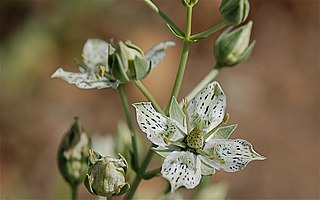
Frasera parryi is a species of flowering plant in the gentian family known by the common name Coahuila frasera.
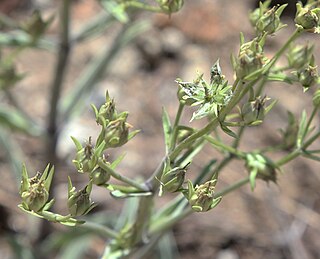
Frasera puberulenta is a species of flowering plant in the gentian family known by the common name Inyo frasera.
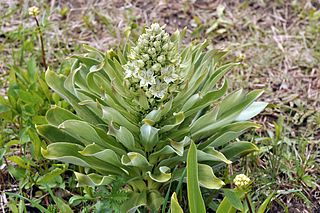
Frasera speciosa is a species of flowering plant in the gentian family (Gentianaceae) known by the common names elkweed, deer's ears, and monument plant.
Frasera tubulosa is a species of flowering plant in the gentian family known by the common name Kern frasera.
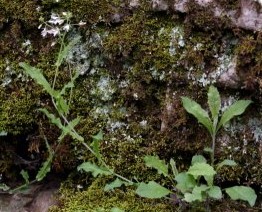
Borodinia perstellata, commonly known as Braun's rockcress and Nevada rockcress, is a rare species of flowering plant in the mustard family. It is native to Kentucky and Tennessee, where it is known from perhaps 25 total populations. Most of the occurrences have few individuals, and all are deteriorating in quality. The plant grows in shady forest habitat on limestone substrates, usually near streams or rivers. This is a federally listed endangered species of the United States.
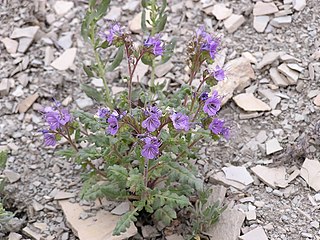
Phacelia argillacea is a rare species of flowering plant in the borage family known by the common names clay phacelia and Atwood's phacelia. It is endemic to Utah in the United States, where it is known only from one canyon in Utah County. It is "one of Utah's most endangered species"; it is "one of the nation's rarest plants" and is federally listed as an endangered species of the United States.

Schoenocrambe argillacea is a rare species of flowering plant in the mustard family known by the common names clay reed-mustard, Uinta Basin plainsmustard, and clay thelypody.

Schoenocrambe barnebyi is a rare species of flowering plant in the mustard family known by the common names Barneby reed-mustard, Syes Butte plainsmustard, and Barneby thelypody. It is endemic to Utah in the United States, where it is known only from Emery and Wayne Counties. It is threatened by habitat degradation and destruction. It is federally listed as an endangered species of the United States.
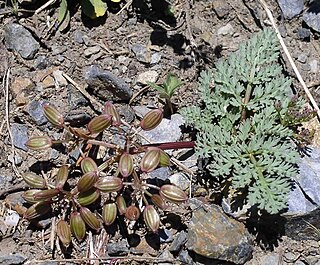
Lomatium erythrocarpum, known by the common name redfruit desertparsley, is a rare species of flowering plant in the carrot family. It is endemic to Oregon in the United States, where it is limited to a section of the Blue Mountains within Baker County.
Lewisia maguirei is a rare species of flowering plant in the family Montiaceae known by the common name Maguire's lewisia, or Maguire's bitterroot. It is endemic to Nevada in the United States, where it is known only from eastern Nye County.

Frasera caroliniensis, commonly known as American columbo or yellow gentian, is a herbaceous perennial of the gentian family Gentianaceae found in the deciduous forest of Southern Ontario and throughout the eastern and southeastern United States. It was previously known as Swertia caroliniensis.

Artemisia filifolia, known by common names including sand sagebrush, sand sage and sandhill sage, is a species of flowering plant in the aster family. It is native to North America, where it occurs from Nevada east to South Dakota and from there south to Arizona, Chihuahua, and Texas.
Chrysothamnus molestus is a species of flowering plant in the family Asteraceae known by the common names Arizona rabbitbrush, Tusayan rabbitbrush, disturbed rabbitbrush, and stickyfruit low rabbitbrush. It is endemic to the State of Arizona in the southwestern United States, where it is known from Coconino, Apache, and Navajo Counties.
Eriogonum crosbyae is a species of wild buckwheat known by the common name Crosby's buckwheat. It is native to southcentral Oregon and northwestern Nevada in the United States. Some treatments include plants in Montana and Idaho as members of this species. This plant was first discovered in the Guano Valley in Lake County, Oregon, in 1978 by Bureau of Land Management botanist Virginia Crosby, and it was named for her in 1981.
Frasera coloradensis is a species of flowering plant in the gentian family known by the common names Colorado green gentian, or Colorado gentian, and Colorado frasera. It is endemic to Colorado in the United States, where it is limited to the southeastern corner of the state.

Hackelia cronquistii is a species of flowering plant in the borage family known by the common name Cronquist's stickseed.













